If you really love your dog, basic dog anatomy is one of the most important things to know about your dog.
Coupled with basic dog health tips, understanding your dog’s anatomy is the foundation of caring for a dog.
If you don’t know how your best canine friend is put together, you simply might not make a good dog parent.
A dedicated dog owner needs the current information that he or she can get about their dogs to offer the best care all the time.
In this post, we have highlighted basic dog anatomy facts as a means of educating new dog parents as well as any other dog lover on what they ought to know about their pooch’s bodies.
Let’s dive in.
1.Skull
Like in humans, your dog’s skull protects his brain. Interestingly, dogs’ skulls differ in terms of shapes and sizes.
The most common ones include:
- Dolichocephalics: Long-headed like King Shepherd breeds
- Brachycephalics: Wide and broader skulls like the Chihuahua
- Mesocephalics: Medium size and shaped skull like the Golden retriever
Note: There are many variations in between the 3 categories
According to a past dog behavioral study, brachycephalics tend to friendlier to humans and somehow more defensive.
On the other hand, dolichocephalics are less playful and more resilient, especially in stressful situations.
2. Skeletal System
- A dog has about 320 bones in the body (although the length of the tail may increase or decrease this number) and around 700 muscles.
- However, dogs lack collar bones (unlike humans), giving them a larger stride for running.
Related Post: Do Dogs Have Clavicles?
- Dogs have 13 ribs in the chest, which wraps up their lungs, heart, and other internal organs. Considering that these organs determine your dog’s speed and stamina, the size of your dog’s chest dictates these traits.
- The skeletons of today’s toy breeds mature in only a few months. However, those of giant breeds such as the Mastiff take up to 16 to 18 months to mature.
3. Paws
- The role of your dog’s paw pads is to cushion his internal leg bones, giving him abrasion and traction resistance. If your dog suffers an injury or trauma on his paws, he is likely to experience loss of limb function.
- Each paw has 5 toes. However, one of them—dewclaw—is situated too high and seldom provide any use
- Your dog perspires through his paw pads (and slightly through the skin).
4. Tongue
- Your dog has a fairly thin tongue which he uses mainly to guide food to his throat, to lick his coat clean, and for perspiration purposes. Hopefully, now you can guess why your dog will hang his tongue out and pant when he is overheated. Well, as he pants, the evaporation of the perspiration from the tongue cools him.
- Clustered around the tip of their tongues are about 1700 taste buds that allow your dog to taste sweet, salty, bitter, and sour. Humans have 10,000 taste buds.
5. Teeth
- Your dog has 42 teeth: 6 pairs of incisors, 2 pairs of large canine teeth, 10 molars and 16 premolars. The canines and incisors are critical as they are what he uses to bite and tear his food.
- Like humans, puppies are born toothless but they soon grow 28 puppy teeth (these are the razor-sharp ‘nails’ that often dig into your fingers). Puppy teeth fall out at around 3 months as adult teeth push them through. Have you seen fallen puppy teeth? Well, if you haven’t, don’t fret as most puppies swallow them!
6. Nails
- A dog’s nail is made up of a harder outer shell, which is black, white or pink depending on the dog breed. Inside the shell is a quick (or soft cuticle), which has nerves and blood supply. When you are trimming your dog’s nails, and the quick accidentally get caught, it will bleed and your dog will be in pain.
Learn more here: 15 Things You Didn’t Know About Dog Nail Anatomy
7. Life Span
The average life span of a dog is about 12 to 14 years though this varies from breed to breed. Here is a good estimate for different breeds:

8. Heart
- Your dog’s heartbeat 70-120 times a minute compared to humans’ which range between 70 and 80 beats a minute. Your dog will take 10-30 breathes every minute.
9. Intelligence
- Your dog can be as smart as a 2-year old child. Border collies, German shepherds, poodles, Dobermans, and Golden retrievers are some of the most intelligent dogs and are capable of understanding up to 200 words.
- Older breeds like bulldogs, beagles, and hound dogs tend to be slow learners—perhaps they were initially bred to hunt and sniff, abilities that need more brawn than brain.
10. Eyes
- Your dog’s eyes have 3 eyelids: the lower and the upper eyelids and the third one tucked between them—in the inner corner of his eye. The third eyelid or the haw acts as a windshield wiper, cleaning the eye and keeping it lubricated.
- Contrary to what most people believe, dogs are not completely color blind. They are red/green color blind though.
- Your dog has a visual range of 250 degrees. Humans have 180 degrees of visual range.
11. Tail
- Your dog’s tail is an extension of his spine, so any kind of injury to the tail can have a detrimental effect on his overall health.
- The bones of the tail have special discs to cushion the gaps between them.
- The nerves and the muscles in the tail plays a significant role in bowel movements and that is why whenever your dog traps his tail in a door, the first question that a vet will ask is about his toileting.
12. Neck
- The neck connects the head and the body of your dog. Depending on the size of the 7 bones that support it, your dog’s neck might be long or short.
- The length of your dog’s vocal cords determines the loudness or pitch of his voice—his bark, grunt, or howl.
13. Gastrointestinal System

- Like other omnivores, dogs have a small intestine that constitutes about 25 percent of their total gastrointestinal volume.
- Food tends to move through a dog’s stomach a bit slower than in humans. However, the food movement through the intestines is a bit faster. So, the gastrointestinal transit time in dogs is about 6-8 hours compared to that of humans that range between 20 and 30 hours.
14. Whiskers
- A dog’s whiskers have special sensory hairs called vibrissae that can sense slight changes in airflow.
15. Hackles
- Hackles are the hair along your dog’s neck and spine. Most dogs raise their hackles during times of stress.
16. Temperature
- Your dog’s temperature ranges between 100.2 and 102.8 degrees Fahrenheit.
17. Hearing Range
- Your dog’s hearing is much bigger—about 67Hz to 45 kHz—than yours (about 64Hz to 23 kHz). So, the next time your Fido ignores you when he searching for a squirrel, just understand that he is busy.
18. Gestation Period
- The average gestation period of dogs is around 63 days—with a few variations. For humans, it lasts around 266 days.
19. Chromosomes
- Your dog is quite complex genetically. Dogs boast 39 pairs of chromosomes compared to 23 pairs in humans.
20. Breed-specific Complications
- 30% of Dalmatians tend to be deaf in one or both ears.
- Because of their extremely short muzzles, most bulldogs spend a bigger percentage of their lives fighting suffocation.
- Chihuahuas have small skulls, which tend to restrict the flow of spinal fluid and may cause swelling of the brain.
There you have it; a few basics about your dog’s anatomy. Hopefully, now you understand your four-legged friend better.
As an Amazon Associate, we may receive a small commission from qualifying purchases but at no extra cost to you. Learn more. Amazon and the Amazon logo are trademarks of Amazon.com, Inc, or its affiliates.

